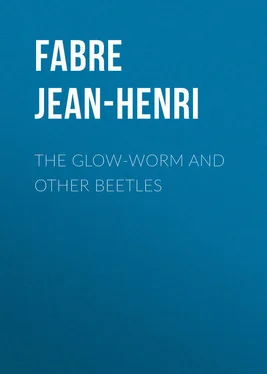Jean-Henri Fabre - The Glow-Worm and Other Beetles
Здесь есть возможность читать онлайн «Jean-Henri Fabre - The Glow-Worm and Other Beetles» — ознакомительный отрывок электронной книги совершенно бесплатно, а после прочтения отрывка купить полную версию. В некоторых случаях можно слушать аудио, скачать через торрент в формате fb2 и присутствует краткое содержание. Жанр: foreign_antique, foreign_prose, на английском языке. Описание произведения, (предисловие) а так же отзывы посетителей доступны на портале библиотеки ЛибКат.
- Название:The Glow-Worm and Other Beetles
- Автор:
- Жанр:
- Год:неизвестен
- ISBN:нет данных
- Рейтинг книги:5 / 5. Голосов: 1
-
Избранное:Добавить в избранное
- Отзывы:
-
Ваша оценка:
- 100
- 1
- 2
- 3
- 4
- 5
The Glow-Worm and Other Beetles: краткое содержание, описание и аннотация
Предлагаем к чтению аннотацию, описание, краткое содержание или предисловие (зависит от того, что написал сам автор книги «The Glow-Worm and Other Beetles»). Если вы не нашли необходимую информацию о книге — напишите в комментариях, мы постараемся отыскать её.
The Glow-Worm and Other Beetles — читать онлайн ознакомительный отрывок
Ниже представлен текст книги, разбитый по страницам. Система сохранения места последней прочитанной страницы, позволяет с удобством читать онлайн бесплатно книгу «The Glow-Worm and Other Beetles», без необходимости каждый раз заново искать на чём Вы остановились. Поставьте закладку, и сможете в любой момент перейти на страницу, на которой закончили чтение.
Интервал:
Закладка:
The number of eggs laid in a single batch is really prodigious. In the first batch, which, it is true, is the most prolific of all, Meloe proscarabæus , according to Newport's calculations, produces the astonishing number of 4,218 eggs, which is double the number of eggs laid by a Sitaris. And what must the number be, when we allow for the two or three batches that follow the first! The Sitares, entrusting their eggs to the very corridors through which the Anthophora is bound to pass, spare their larvæ a host of dangers which the larvæ of the Meloe have to run, for these, born far from the dwellings of the Bees, are obliged to make their own way to their hymenopterous foster-parents. The Oil-beetles, therefore, lacking the instinct of the Sitares, are endowed with incomparably greater fecundity. The richness of their ovaries atones for the insufficiency of instinct by proportioning the number of germs in accordance with the risks of destruction. What transcendent harmony is this, which thus holds the scales between the fecundity of the ovaries and the perfection of instinct!
The hatching of the eggs takes place at the end of May or in June, about a month after they are laid. The eggs of the Sitares also are hatched after the same lapse of time. But the Meloe-larvæ, more greatly favoured, are able to set off immediately in search of the Bees that are to feed them; while those of the Sitares, hatched in September, have to wait motionless and in complete abstinence for the emergence of the Anthophoræ the entrance to whose cells they guard. I will not describe the young Meloe-larva, which is sufficiently well known, in particular by the description and the diagram furnished by Newport. To enable the reader to understand what follows, I will confine myself to stating that this primary larva is a sort of little yellow louse, long and slender, found in the spring in the down of different Bees.
How has this tiny creature made its way from the underground lodging where the eggs are hatched to the fleece of a Bee? Newport suspects that the young Oil-beetles, on emerging from their natal burrow, climb upon the neighbouring plants, especially upon the Cichoriceæ, and wait, concealed among the petals, until a few Bees chance to plunder the flower, when they promptly fasten on to their fur and allow themselves to be borne away by them. I have more than Newport's suspicions upon this curious point; my personal observations and experiments are absolutely convincing. I will relate them as the first phase of the history of the Bee-louse. They date back to the 23rd of May, 1858.
A vertical bank on the road from Carpentras to Bédoin is this time the scene of my observations. This bank, baked by the sun, is exploited by numerous swarms of Anthophoræ, who, more industrious than their congeners, are in the habit of building, at the entrance to their corridors, with serpentine fillets of earth, a vestibule, a defensive bastion in the form of an arched cylinder. In a word, they are swarms of A. parietina . A sparse carpet of turf extends from the edge of the road to the foot of the bank. The more comfortably to follow the work of the Bees, in the hope of wresting some secret from them, I had been lying for a few moments upon this turf, in the very heart of the inoffensive swarm, when my clothes were invaded by legions of little yellow lice, running with desperate eagerness through the hairy thickets of the nap of the cloth. In these tiny creatures, with which I was powdered here and there as with yellow dust, I soon recognized an old acquaintance, the young Oil-beetles, whom I now saw for the first time elsewhere than in the Bees' fur or the interior of their cells. I could not lose so excellent an opportunity of learning how these larvæ manage to establish themselves upon the bodies of their foster-parents.
In the grass where, after lying down for a moment, I had caught these lice were a few plants in blossom, of which the most abundant were three composites: Hedypnois polymorpha , Senecio gallicus and Anthemis arvensis . Now it was on a composite, a dandelion, that Newport seemed to remember seeing some young Oil-beetles; and my attention therefore was first of all directed to the plants which I have named. To my great satisfaction, nearly all the flowers of these three plants, especially those of the camomile ( Anthemis ) were occupied by young Oil-beetles in greater or lesser numbers. On one head of camomile I counted forty of these tiny insects, cowering motionless in the centre of the florets. On the other hand, I could not discover any on the flowers of the poppy or of a wild rocket ( Diplotaxis muralis ) which grew promiscuously among the plants aforesaid. It seems to me, therefore, that it is only on the composite flowers that the Meloe-larvæ await the Bees' arrival.
In addition to this population encamped upon the heads of the composites and remaining motionless, as though it had achieved its object for the moment, I soon discovered yet another, far more numerous, whose anxious activity betrayed a fruitless search. On the ground, in the grass, numberless little larvæ were running in a great flutter, recalling in some respects the tumultuous disorder of an overturned Ant-hill; others were hurriedly climbing to the tip of a blade of grass and descending with the same haste; others again were plunging into the downy fluff of the withered everlastings, remaining there a moment and quickly reappearing to continue their search. Lastly, with a little attention, I was able to convince myself that within an area of a dozen square yards there was perhaps not a single blade of grass which was not explored by several of these larvæ.
I was evidently witnessing the recent emergence of the young Oil-beetles from their maternal lairs. Part of them had already settled on the groundsel- and camomile-flowers to await the arrival of the Bees; but the majority were still wandering in search of this provisional refuge. It was by this wandering population that I had been invaded when I lay down at the foot of the bank. It was impossible that all these larvæ, the tale of whose alarming thousands I would not venture to define, should form one family and recognize a common mother; despite what Newport has told us of the Oil-beetles' astonishing fecundity, I could not believe this, so great was their multitude.
Though the green carpet was continued for a considerable distance along the side of the road, I could not detect a single Meloe-larva elsewhere than in the few square yards lying in front of the bank inhabited by the Mason-bee. These larvæ therefore could not have come far; to find themselves near the Anthophoræ they had had no long pilgrimage to make, for there was not a sign of the inevitable stragglers and laggards that follow in the wake of a travelling caravan. The burrows in which the eggs were hatched were therefore in that turf opposite the Bees' abode. Thus the Oil-beetles, far from laying their eggs at random, as their wandering life might lead one to suppose, and leaving their young to the task of approaching their future home, are able to recognize the spots haunted by the Anthophoræ and lay their eggs in the near neighbourhood of those spots.
With such a multitude of parasites occupying the composite flowers in close proximity to the Anthophora's nests, it is impossible that the majority of the swarm should not become infested sooner or later. At the time of my observations, a comparatively tiny proportion of the starving legion was waiting on the flowers; the others were still wandering on the ground, where the Anthophoræ very rarely alight; and yet I detected the presence of several Meloe-larvæ in the thoracic down of nearly all the Anthophoræ which I caught and examined.
I have also found them on the bodies of the Melecta- and Coelioxys-bees, 20 20 Cf. The Mason-bees: chaps. viii. and ix. — Translator's Note .
who are parasitic on the Anthophoræ. Suspending their audacious patrolling before the galleries under construction, these spoilers of the victualled cells alight for an instant on a camomile-flower and lo, the thief is robbed! A tiny, imperceptible louse has slipped into the thick of the downy fur and, at the moment when the parasite, after destroying the Anthophora's egg, is laying her own upon the stolen honey, will creep upon this egg, destroy it in its turn and remain sole mistress of the provisions. The mess of honey amassed by the Anthophora will thus pass through the hands of three owners and remain finally the property of the weakest of the three.
Интервал:
Закладка:
Похожие книги на «The Glow-Worm and Other Beetles»
Представляем Вашему вниманию похожие книги на «The Glow-Worm and Other Beetles» списком для выбора. Мы отобрали схожую по названию и смыслу литературу в надежде предоставить читателям больше вариантов отыскать новые, интересные, ещё непрочитанные произведения.
Обсуждение, отзывы о книге «The Glow-Worm and Other Beetles» и просто собственные мнения читателей. Оставьте ваши комментарии, напишите, что Вы думаете о произведении, его смысле или главных героях. Укажите что конкретно понравилось, а что нет, и почему Вы так считаете.












